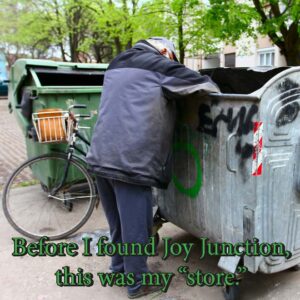By Jeremy Reynalds, Ph.D.
Founder and CEO
Joy Junction Inc.
 There’s enough of a hunger problem in New Mexico that the noise you hear sometimes may not be your neighbor trying to start his car. It could be his growling stomach.
There’s enough of a hunger problem in New Mexico that the noise you hear sometimes may not be your neighbor trying to start his car. It could be his growling stomach.
According to the New Mexico Association of Food Banks, nearly 70,000 New Mexicans seek food assistance weekly. That’s the equivalent of a city the size of Santa Fe needing emergency assistance every week.
Between 30 and 40 percent of the members of households seeking food assistance are children under the age of 18.
Twenty-one percent of the people seeking food assistance in New Mexico are senior citizens.
Sixty-one percent of households report that in the previous year they had to choose between paying utilities or buying food. Of this group, 33 percent reported that they have to make this tough choice every month.
Forty-eight percent of households report having to choose between paying their rent or mortgage or buying food. Nineteen percent of this group are forced to make this choice every month.
Sometimes, we forget that behind the statistics are hungry people with growling stomachs.
I guess that I could have easily become a statistic back in the early 1980’s, when I was both homeless and hungry for a while. The complete story is told in my book “From Destitute to Ph.D.” I remember how good a bologna sandwich tastes when you haven’t eaten for a while.
It was prayerful concern and actual help from unexpected sources that assured I didn’t stay on the side of a highway hoping for my next meal.
My own experiences also helped me empathize with the many homeless and hungry clients who continue to be served by Joy Junction. Did you know that between our Lifeline of Hope mobile feeding units and meals we serve at our South Valley facility that we provide more than 16,000 meals each month.
Clients often say that it’s the only meal they’ve eaten (or expect to eat) for the day. They’re so appreciative. 
The number of meals you help us provide might not seem much in comparison to the overall need, but you’re helping us make a difference. As a result, fewer people are going to bed hungry and with growling stomachs each evening.
People often ask me whether hunger and homelessness are increasing. It’s hard to give a definitive answer about homelessness, but based upon the number of people we feed, hunger is definitely a growing problem.
I wanted to help further personalize hunger for you, so I asked our resident service manager at Joy Junction to find out from a few of our guests what it felt like. They were quick to respond.
One man said when he’s been hungry for a while, he feels “weak and sad, a little depressed.”
He recalled one time not eating for 12 hours. When he finally got food, “I ate too much and vomited. I don’t remember where the meal came from. I was just so happy.”
This guy said there’s evidence of New Mexico’s hunger problem statewide. “I don’t like seeing people hungry. Thank God for Joy Junction. I wish more people would donate more money and food here. We need it.”
He said Joy Junction feeds him well. There was an interesting caveat. “I may not like all of the meals, but at least I’m not going hungry like so many others.”
Another man said he’s always hungry when he doesn’t make it to Joy Junction, but he appreciates the food when he gets there.
He recalled a recent meal at the shelter. “It was great. I don’t even remember what it was. It could’ve been dog (crap) for all I care. I was starving.”
And hunger in New Mexico? “Kind of a dumb question. Of course there’s a hunger problem. But, I don’t know how to fix it. Just keep feeding people here. You’re doing a good job, I guess. You have fed me, housed me, clothed me. Keep doing what you’re doing.”
A man who at time of writing has stayed at Joy Junction for a month, said “everyone has been hungry.”
He continued, “We feel tired and weak. We feel depressed. We feel like losers.”
On a more positive note. “Joy Junction has helped me with getting food. I’m glad now. I don’t feel so bad now that I have a place to call home. If we built more places like Joy Junction, we wouldn’t have a hunger problem.”
One Joy Junction guest said, “Since I’ve been here now for a week or so. I’ve fattened up. After eating here, I felt normal again.”
She said that New Mexico doesn’t take care of the homeless, adding “Joy Junction helps the homeless. I can’t even get food stamps. New Mexico is a horrible place to live.”
“Thanks for feeding me,” she said. “I got a clothing voucher yesterday. I don’t know how to thank you. Jesus is at Joy Junction.”
Another guest said she has been hungry. She said that everyone gets hungry, so much so that it’s a part of life.
When this woman’s stomach cries out for food, it makes her physically tired and weak, as well as emotionally sad and angry.
She continued, “When I eat here after I’ve been gone for a while, I feel happy and thankful.”
This woman said that not just New Mexico, but America has a hunger problem.
“People don’t want to help the poor,” she said. “Panhandlers are made fun of. I was panhandling last week and someone gave me their trash instead of cash. They laughed and drove off. People don’t give a s**! I’m glad that I have a place to eat here.”
One woman said she appreciates the food at Joy Junction, describing it as “great.”
She added, “I’m not sure how the hunger issue is here in New Mexico. I’m pretty sure it’s bad since we need a place like Joy Junction. I have no idea how to fix it. Maybe we need more food banks and shelters.”
One man, who described himself as “growing up on the reservation,” had a different perspective.
He said, “We don’t go hungry there because everyone feeds you. There are no homeless on the reservation. Did you know that?”
However, it’s different when you come to the city and lose your job, he said. That’s when you go hungry.
“That’s what happened to me. But, now I’m an outcast back home. They all are ashamed of me. I felt pretty grateful for getting food after going without for so long. Someone gave me a turkey leg last year from the State Fair.”
Almost reflectively he added, “Joy Junction is a lifeline of hope. It’s just like the truck says.”
I was curious to learn more about hunger on the Indian reservations.
The Indian Relocation Act of 1956 (also known as Public Law 959 or the Adult Vocational Training Program) was a United States law intended to encourage Native Americans in the United States to leave Indian reservations, acquire vocational skills, and assimilate into the general population.
This program played a significant role in increasing the population of urban American Indians in succeeding decades.
However, as Joy Junction Resident Services Manager Denis Billy (an American Indian) said, “This program was very helpful for some, but became a detriment for others. Many American Indians fell victim to alcoholism and drug addiction. Those who failed at a life in the city returned to the reservation in shame. Their addictions continued on the reservation, and, for some, took their life of addiction back from whence it came.”
Billy said as such, he agreed with the statement above from our American Indian guest. He added, “Back in the 60s, my mother worked with program in San Francisco and Oakland. She assisted American Indians with learning to live in the city-a huge contrast from the reservation.”
However, according to one article, while there may be food on many reservations, there is a lack of nutritional items, resulting in older Native Americans being hit particularly hard.
The same article said the U.S. Department of Agriculture considers most reservations “food deserts” — low-income areas where many people lack access to nutritional foods.
According to the Center for Rural Health, about 6 in 10 Native Americans age 55 and older survive on between $5,000 and $10,000 a year. The combination of rampant poverty and low-quality food hits tribal elders particularly hard.
Another man told us that during his time of homelessness in Texas he felt he was all alone emotionally and physically with no one to help.
Eating his first meal after being hungry, he said, was “a very happy feeling.”
He said he feels there is a definite hunger issue in New Mexico, and the state should build more homeless shelters.”
This man was very appreciative for everything he has received at Joy Junction.
So what can be done to help quell hunger in New Mexico? I agree with the New Mexico Association of Food Banks. We need to educate ourselves and others about hunger.
We’d love to give you a tour of Joy Junction, and have one of our staff give a presentation about hunger and homelessness at your organization, workplace, school or place of worship.
We’d also love to have you volunteer at Joy Junction. We hold daily volunteer orientation tours seven days a week at 11 am at our 4500 Second Street SW facility.
While we will almost certainly never end the universality of hunger as we know it, we can “end” hunger one meal at a time. You can make a difference. I hope you will get involved by making a secure donation at www.joyjunction.org


